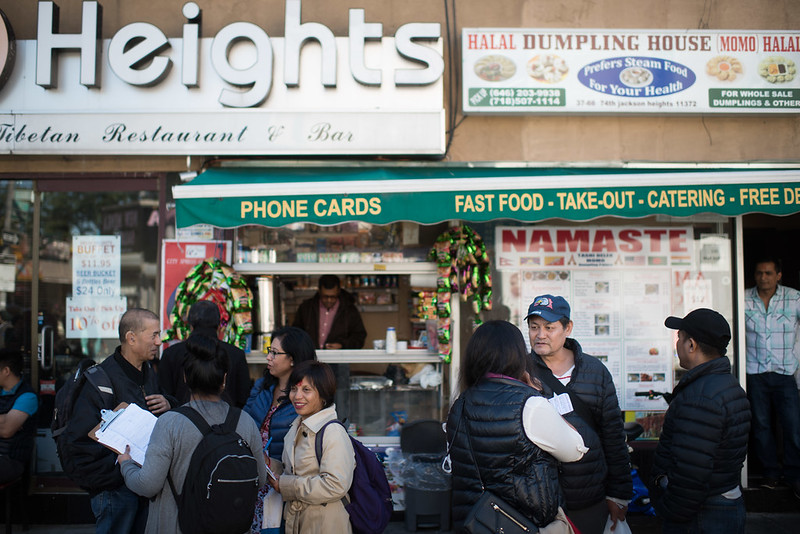
(photo: Michael Appleton/Mayor's Office)
Ask any New Yorker and they will tell you how neighborhood streets that once bustled with small, mom-and-pop businesses now have a Duane Reade on one corner and a large bank on the other, with a row of empty stores in between. When I was growing up in Washington Heights, like a lot of New Yorkers, I could walk down the street to the local corner store where they knew my name and could even guess what I wanted before I started talking. That’s what made growing up in the city so special – the local institutions embedded in the fabric of our neighborhoods. But nowadays, that reality is disappearing.
This is a moment of tremendous challenge for the thousands of local small businesses that have been a source of vibrancy, character, and diversity for our neighborhoods for generations. Tragically, these vital establishments are closing at an alarming rate from one end of the city to the other. Every New Yorker sees it — and feels it, too.
Last week, my office released the most comprehensive analysis to date in a first-of-its-kind report, reviewing data from the Department of Finance over a decade that puts numbers behind the phenomenon of retail vacancies playing out across the city.
What we found was that the amount of vacant storefront space across the city has doubled since 2007 — from around 6 million square feet to more than 11 million square feet. The city’s vacancy rate citywide rose by 45 percent from 2007 to 2017, to nearly 6 percent. The report offers a startling picture of new economic trends in communities across the five boroughs.
While Manhattan neighborhoods account for nearly half of the 20 neighborhoods with the most empty square footage -- including Chelsea, Canal Street, and even along 5th Avenue -- the neighborhoods with the highest rates of vacancy are in the other boroughs, in neighborhoods from Little Neck and Jackson Heights in Queens to Throggs Neck and Mott Haven in the Bronx and New Dorp and Rossville on Staten Island.
The reasons for this are complex but nonetheless crucial for us to consider and comprehend if we’re going to give mom-and-pop businesses a fighting chance – not just to stay afloat, but to thrive.
Yes, there are landlords who are pushing for the highest rents they can set and are willing to let storefronts sit empty for months to do so. But it’s not just that – it’s also the changing nature of how people shop today. Call it the “Amazon Effect,” where we increasingly buy everything from mattresses to groceries online. As a result, we’re seeing an exodus of traditional merchandise stores, replaced with new businesses that are service-oriented.
The result is a wave of closures of flower shops, independent pharmacies, bookstores, and more. Independent bookstores and pharmacies are being replaced by chain coffee shops, cycling studios, and doggie daycare. Between 2007 and 2017, the number of service businesses rose by nearly 50 percent, and bars and restaurants soared by 65 percent – while traditional retail storefronts grew by just 19 percent.
Meanwhile, rents are rising on ground-floor retail — by 22 percent citywide from 2007 to 2017, and by much more in neighborhoods from Greenwich Village to Douglaston, Annandale to Central Harlem — hurting our smaller, independent stores the most. They are being hit twice, by changing shopping habits and rising rents, and it’s making it almost impossible to compete with online retailers.
If we’re going to offer relief, we should be taking a hard look at the regulatory hurdles that stall turnover of retail space. There’s a lot that needs to happen for a bookstore to become a coffee shop: licenses have to be approved by a community board and agencies need to approve alterations and conduct inspections for health and safety. The process is confusing and convoluted — and it’s making vacancies more common, and more prolonged, while hurting the chances that new businesses are run by New Yorkers invested in their local communities instead of big corporations.
We must streamline the process. We can create a one-stop shop for our small businesses, and break down the silos in city government that are hurting, not helping. The bureaucracy has to act faster and in a much more coordinated fashion. Our city agencies must get on a track to streamline those conversions and make it easier to open up shop.
Let’s also help new retail businesses get a foothold by offering a tax break to independent local businesses — not national chains — in high-vacancy retail corridors. And let’s use this data to plan our city with retail space in mind. Too often developers build out retail space that ends up sitting vacant. We need to plan smarter, more comprehensively, and embrace an approach to planning for new residential and commercial buildings that allows neighborhoods to capture diverse retail opportunities.
If we don’t adapt, our local businesses that define our neighborhoods, bring life to our city, and provide goods and services to residents they’ve built relationships with, will disappear.
It’s time we rethink our approach to support our local neighborhood anchors, the mom-and-pop stores that line our streetscapes and serve as some of our most vivid markers in communities across the city. Understanding the changing reality is the place to start. We have the power to shape our commercial corridors and therefore our neighborhoods — let’s take the right steps to move them forward.
***
Scott Stringer is the New York City Comptroller. On Twitter @NYCComptroller.
***
Have an op-ed idea or submission for Gotham Gazette? Email This email address is being protected from spambots. You need JavaScript enabled to view it.